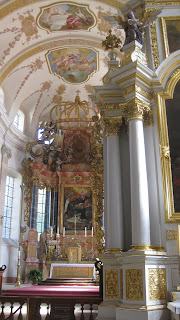The biggest Cathedral in the Americas? (Flickr : Pinkitron)
The Metropolitan Cathedral of the Assumption of the Most Blessed Virgin Mary into Heaven is the Cathedral of the Roman Catholic diocese of Mexico.and has been described as the largest Cathedral in the Americas.
I have never set eyes on this but I am always fascinated by big buildings! As we shall see it is not strictly speaking Baroque but then many of my choices in this blog are a mixture. It was built on the foundations of the former Aztec sacred precinct and main temple of their capital city Tenochtitlan. Parts of the old temple were used to fill canals or as building material in foundations or ground walls. The first building was started in 1525-1532 by the conqueror Hernan Cortes.The present building took shape from 1573-1813 around the original church,The Spanish architect Claudio de Arciniega made the plans and can be described as the father of the present cathedral. Priority in planning had to be given to lay firm foundations on the soft ground of a dry lake bed in an earthquake zone. By 1615 the walls were only up to half the proposed height but eight vaulkts had been completed. It was consecrated in 1656. It is 360 feet long by 179feet. It is a real merger of styles and incorporates Renaissance, Baroque and Neoclassical elements, and is built of basalt and grey sandstone. There are four facades,and 16 chapels with paintings attributed to Zurburan and Murillo. The two bell towers with the 25 bells are important. They could announce disaster like earthquakes or good news like a fiesta or some kind of victory. . The interior has 3 aisles There are 2 large 18th century organs which were damaged in a recent fire. They promise to be really exciting with the usual array of protruding chamade reeds.
Adjoining is the Sagrario Metropolitano which is of the Cathedral. The Sagrario serves the local parish and was inaugurated in 1768. It is a great example of Mexican Churrigueresque style, and is the work of Lorenzo Rodriguez (1704?-1774) a Spanish born architect and Pedro Patino Ixtolinque, a native born sculptor.
Much more could be said about this hhuge building. Maybe someone will add some material / show their enthusiasm! I have never got to Mexico and is not Mexico City the biggest city in the world?
Interior (Flickr : VasenkaPhotography)
La Romanesca con Cinque Mutanze - Antonio Valente.
Mexico City Cathedral before 1967






















































